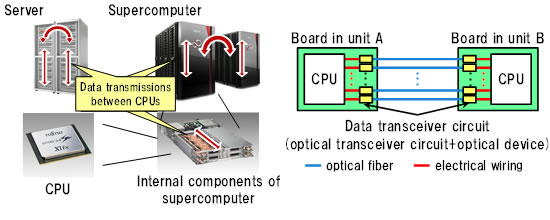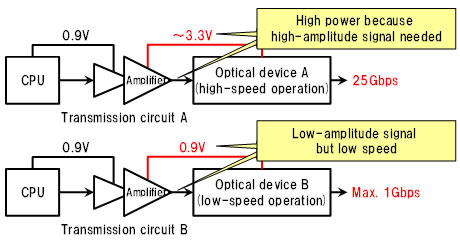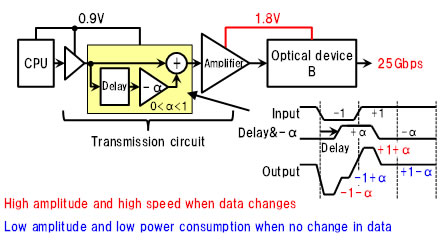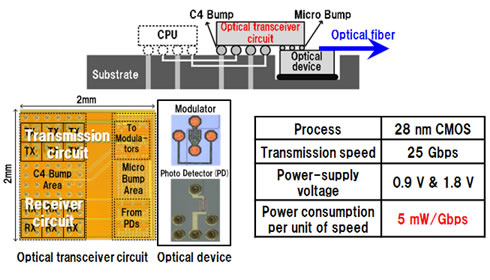Archived content
NOTE: this is an archived page and the content is likely to be out of date.
Fujitsu, PETRA, and NEDO Achieve World's Lowest Energy Requirements of 5 mW per 1 Gbps for High-Speed Inter-Processor Data Transmissions
Silicon photonics technology used to successfully halve power requirements
Fujitsu Limited,Fujitsu Laboratories Ltd.,Fujitsu Laboratories of America Inc.,Photonics Electronics Technology Research Association,New Energy and Industrial Technology Development Organization
-
[1] Silicon photonics
Technology in which an optical device is configured on a silicon substrate. By using silicon, optical circuits can be made smaller, enabling large-scale integration. It also has other merits, such as the ability to configure optical circuits and electronic circuits in one unit, and lower manufacturing costs.
-
[2] Gbps
Gigabits (billion bits) per second.
About Fujitsu
Fujitsu is the leading Japanese information and communication technology (ICT) company offering a full range of technology products, solutions and services. Approximately 162,000 Fujitsu people support customers in more than 100 countries. We use our experience and the power of ICT to shape the future of society with our customers. Fujitsu Limited (TSE: 6702) reported consolidated revenues of 4.8 trillion yen (US$46 billion) for the fiscal year ended March 31, 2014. For more information, please see http://www.fujitsu.com.
About Fujitsu Laboratories
Founded in 1968 as a wholly owned subsidiary of Fujitsu Limited, Fujitsu Laboratories Ltd. is one of the premier research centers in the world. With a global network of laboratories in Japan, China, the United States and Europe, the organization conducts a wide range of basic and applied research in the areas of Next-generation Services, Computer Servers, Networks, Electronic Devices and Advanced Materials. For more information, please see: http://www.fujitsu.com/jp/group/labs/en/.
About Fujitsu Laboratories of America
Fujitsu Laboratories of America, Inc. is a wholly owned subsidiary of Fujitsu Laboratories Ltd. (Japan), focusing on research on Internet, interconnect technologies, software development and solutions for several industry verticals. Conducting research in an open environment, it contributes to the global research community and the IT industry. It is headquartered in Sunnyvale, CA.
For more information, please see: http://www.fla.fujitsu.com
About PETRA
PETRA is a research association in JAPAN for developing innovative technologies in Photonics-Electronics convergence system.
PETRA was established in 2009, and consists of 11 companies, 1 National Laboratory and 1 Association.
About NEDO
Following its establishment as a semi-governmental organization in 1980, the New Energy and Industrial Technology Development Organization (NEDO) is Japan's largest public research and development management organization. NEDO undertakes technology development and demonstration activities to carry out two basic missions, addressing energy and global environmental issues and enhancing industrial technology, by integrating the combined efforts of industry, academia, and government.
Technical Contacts
ICT Systems Laboratories
Server Technologies Lab
![]() E-mail: SiPh_ISSCC2015@ml.labs.fujitsu.com
E-mail: SiPh_ISSCC2015@ml.labs.fujitsu.com
Company:Fujitsu Laboratories Ltd.
All company or product names mentioned herein are trademarks or registered trademarks of their respective owners. Information provided in this press release is accurate at time of publication and is subject to change without advance notice.
Date: 23 February, 2015
City: Tokyo and Kawasaki, Japan, and Sunnyvale, CA
Company:
Fujitsu Limited, Fujitsu Laboratories Ltd., Fujitsu Laboratories of America Inc., Photonics Electronics Technology Research Association, New Energy and Industrial Technology Development Organization



